Interested in baking the perfect flavored focaccia bread with tomatoes and cheese? With this recipe, you can learn detailed step-by-step tips from a former Italian culinary student.
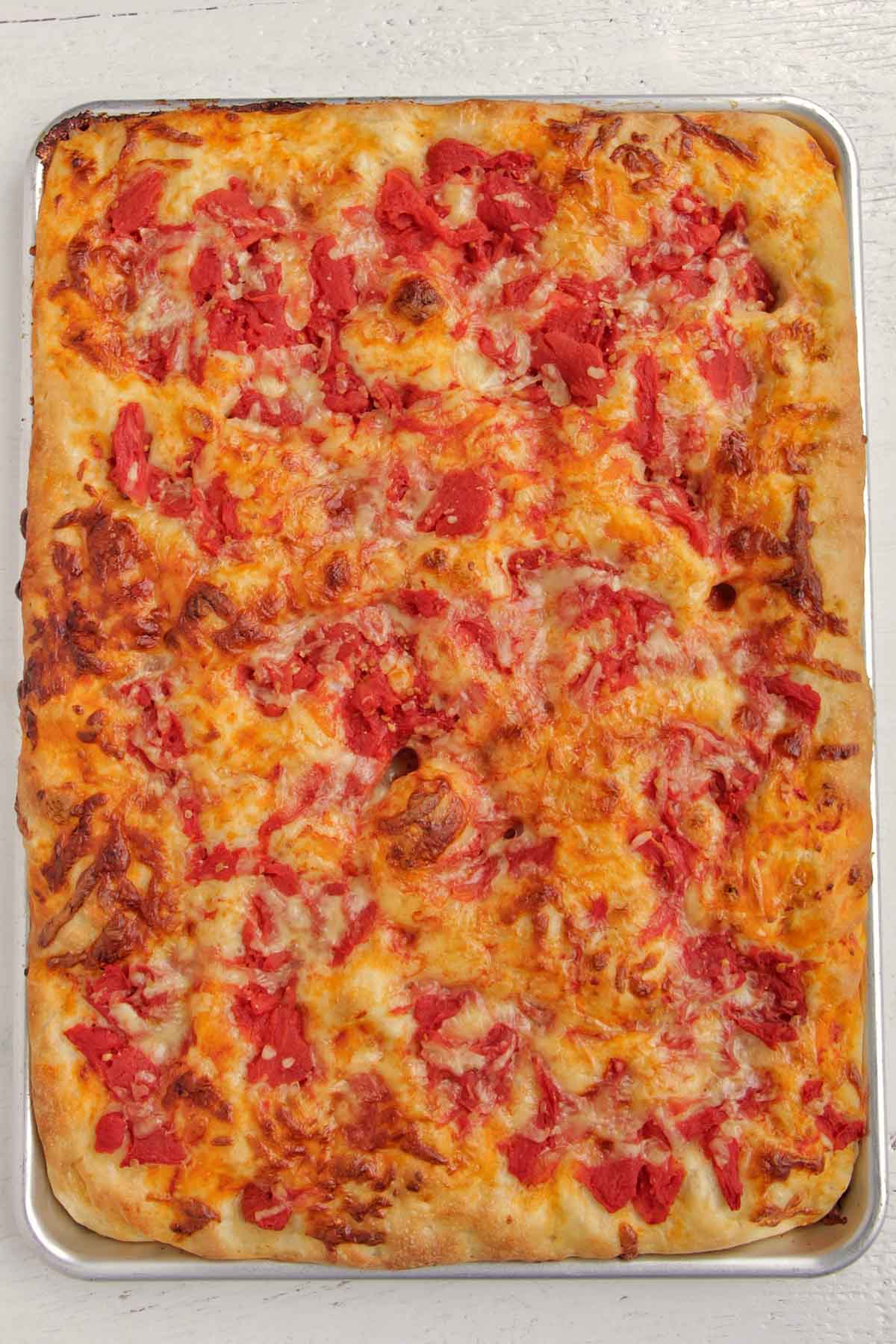
Want To Save This Article?
Enter your email below and we'll send it straight to your inbox. Plus, you'll receive new weekly recipe inspiration.
While you may have made plain focaccia bread before, odds are you haven’t made a flavored version of this famous Italian bread.
When I was studying at culinary school in Italy, I learned the proper way to make focaccia. Now, I want to share that knowledge with you!
Focaccia Pugliese, or tomato focaccia, comes from the Italian region of Puglia. Recreate this authentic dish and spice it up by including cheese to get a crunchy, airy, and cheesy focaccia that will keep you wanting more.
Whether you’re a novice bread baker or a pro, with this recipe and my tips and tricks, you’ll be making the perfect authentic Italian focaccia at home.
For more focaccia, check out this list of the best Italian focaccia bread recipes.
Jump to:
What You'll Learn In This Recipe
- Step by step how to make focaccia bread with cheese.
- Helpful tips for rising and proofing bread at home.
- How to store and reheat focaccia so it always tastes fresh.
If you're interested in learning more about baking, check out this free guide where I share secrets to baking better bread:
Ingredients You Need
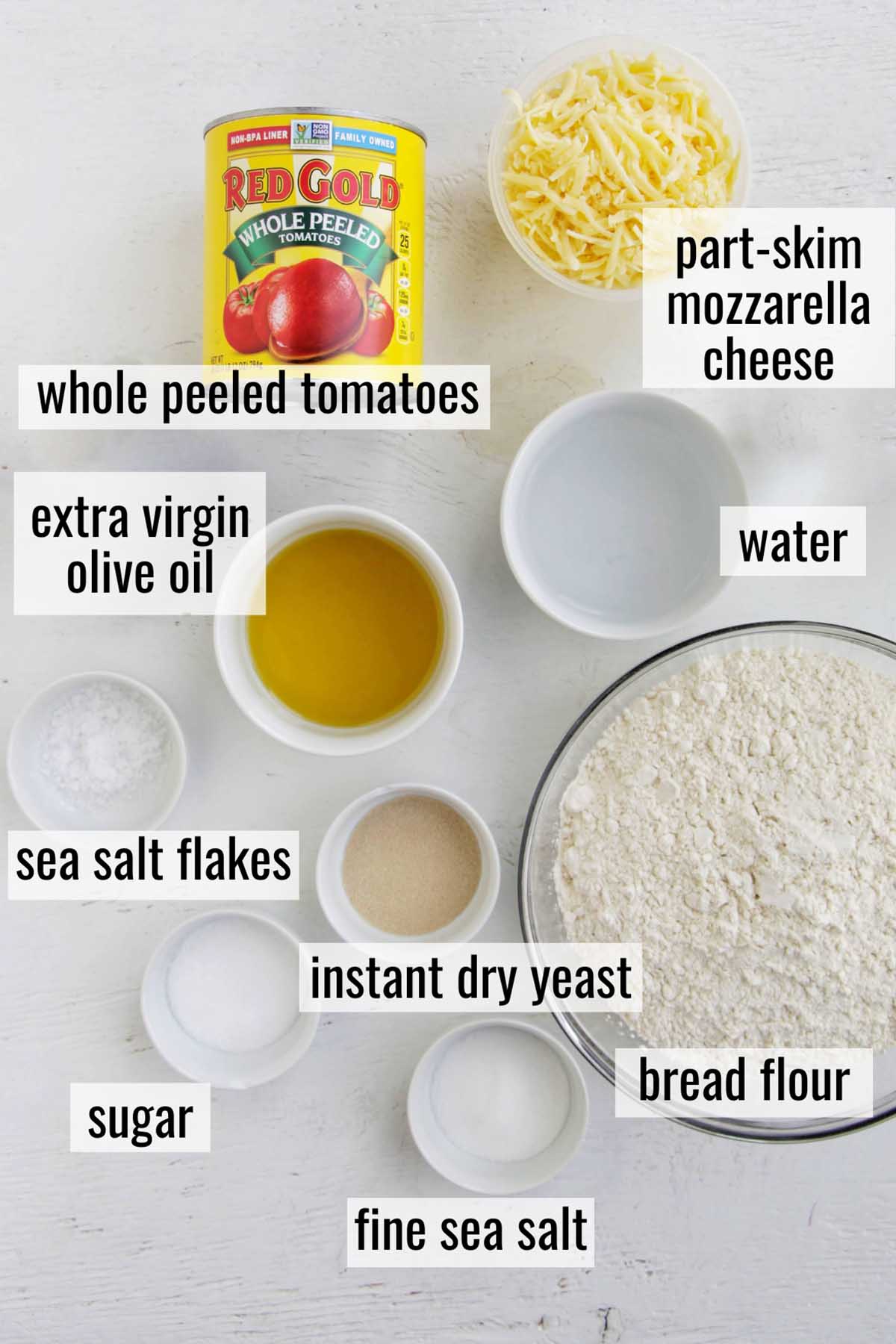
Extra virgin olive oil: Extra virgin olive oil is arguably the most important ingredient in Italian cooking. To achieve the best flavor and quality in your focaccia, be sure your olive oil is extra virgin.
If you want to learn more, check out my guide that teaches all about Italian olive oil.
Instant dry yeast: Yeast is an essential ingredient for nearly all bread recipes. Yeast is the ingredient that gives your dough and bread the ability to rise. Always check that your yeast has not expired before using it in your baking.
If you only have access to active dry yeast, you can substitute the instant yeast for 2 ½ teaspoons of active dry yeast.
Bread flour: It is very important to use bread flour and not all-purpose flour in this recipe because bread flour has a higher protein content. The protein content ultimately affects the final texture of the bread.
I found through various recipe and taste tests that substituting bread flour for all-purpose flour results in an overall less crunchy and airy focaccia bread.
Fine sea salt: Salt is responsible for a few different things in this focaccia recipe with cheese. Not only does salt enhance the flavors of the other ingredients in the bread, but it also strengthens the gluten net in the dough.
The gluten net is what forms the dough and binds everything together. Adding salt will make the dough more resistant and elastic.
Because the extra virgin olive oil will damage the gluten net, it is important to add salt to strengthen the dough and keep everything in form. You will be able to see this process happening when you add the salt to your dough.
Granulated Sugar: Sugar is an ingredient that doesn’t seem to do much but actually does a lot when baking bread. Sugar is food for yeast.
Additionally, the sugar caramelizes when baked, allowing the bread to take on a beautiful golden brown color.
Maldon Sea Salt Flakes: Sea salt flakes are the perfect topping to just about any focaccia bread. It adds that nice salty taste while also providing a bit of extra crunch when biting into the bread.
I use the Maldon brand, but you can use any type of flaky salt for this.
Water: Water is very important for focaccia bread making. Focaccia is a high-hydration dough, meaning that there is a higher percentage of water than the other ingredients in the dough.
Make sure you are using warm water (105°F - 115°F or 40°C - 46°C) when mixing with the yeast and flour. If the temperature of the water is over 140°F (60°C), the heat will kill the yeast. If your yeast dies, your bread won't rise.
Whole peeled tomatoes: Whole peeled tomatoes are the star of this flavored focaccia. Not only will they give the recipe a really nice sweet tomato flavor, but the water content of the tomatoes will help the focaccia get even crispier when it bakes.
I avoid using tomatoes with the skin still on them because it burns easier than the rest of the tomato. Using whole peeled tomatoes is also the authentic Pugliese way of making this style of focaccia.
Part-skim mozzarella cheese: Part-skim mozzarella cheese is the ingredient that will give your focaccia that nice cheesy bite to it. This cheese melts beautifully when baked and will give your cheese focaccia a familiar pizza style.
How To Make This Recipe
Here's a step-by-step guide on how to make cheesy focaccia bread. If you take the time and effort to follow this recipe, it will absolutely pay off with a delicious tasting loaf of bread.
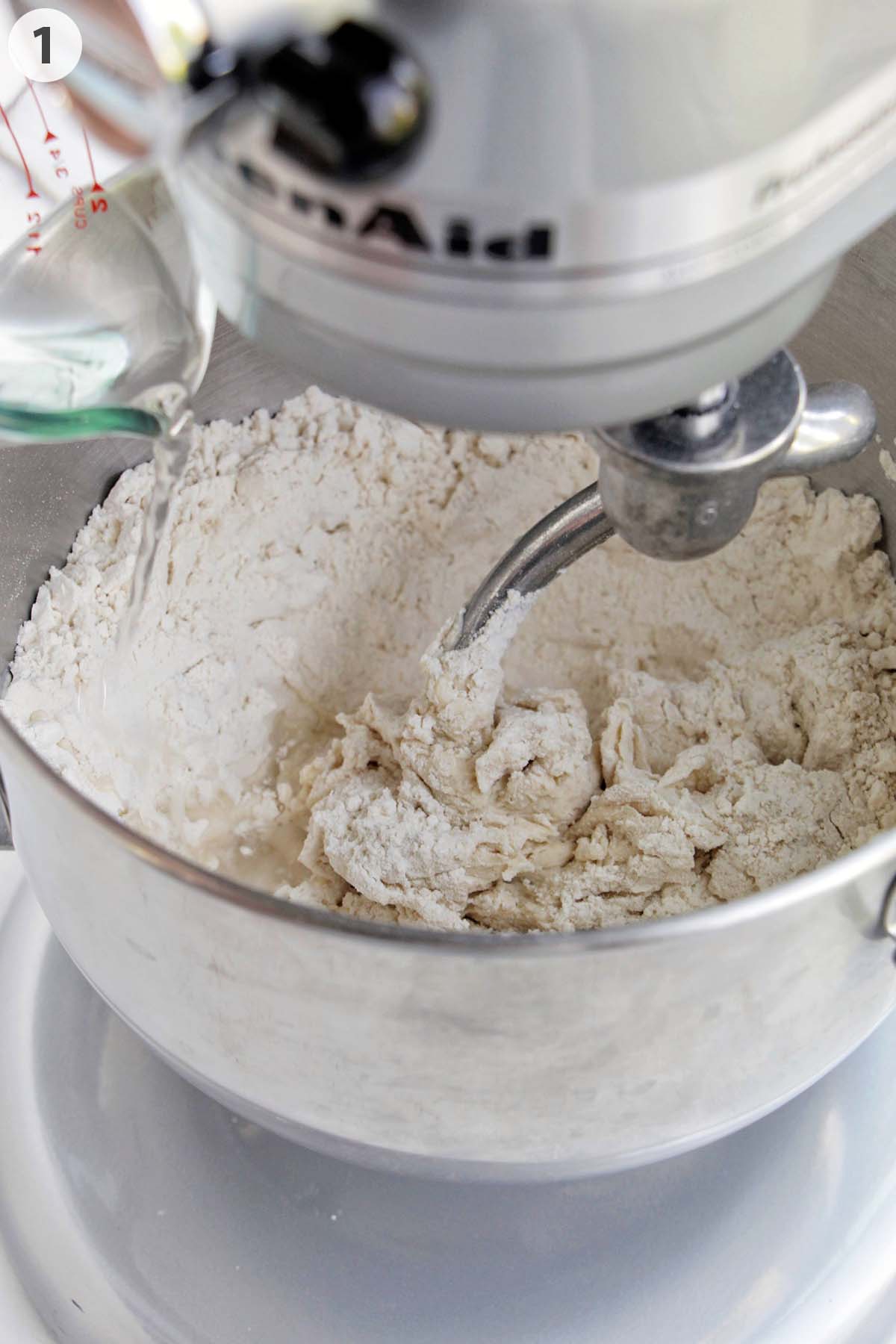
1. To begin the process of making your bread, you’ll need to mix up the focaccia dough.
Start by adding the bread flour and the instant dry yeast into a stand mixer fitted with a dough hook attachment. Turn the mixer to a medium-low speed and let the flour and yeast combine. This recipe cannot be made by hand, so make sure you have access to a stand mixer.
Leave the mixer on a medium-low speed, and slowly add in the water. By eye, add the water in three batches, pouring each batch in gently.
Because focaccia is a high-hydration dough, it is important to allow the water to absorb into the flour before adding in another small amount of water.
You’ll be able to see if the flour has absorbed the water if there is no visible liquid at the bottom of the mixer.
After the water is fully absorbed, gently add in the sugar and let it mix until it is fully incorporated.
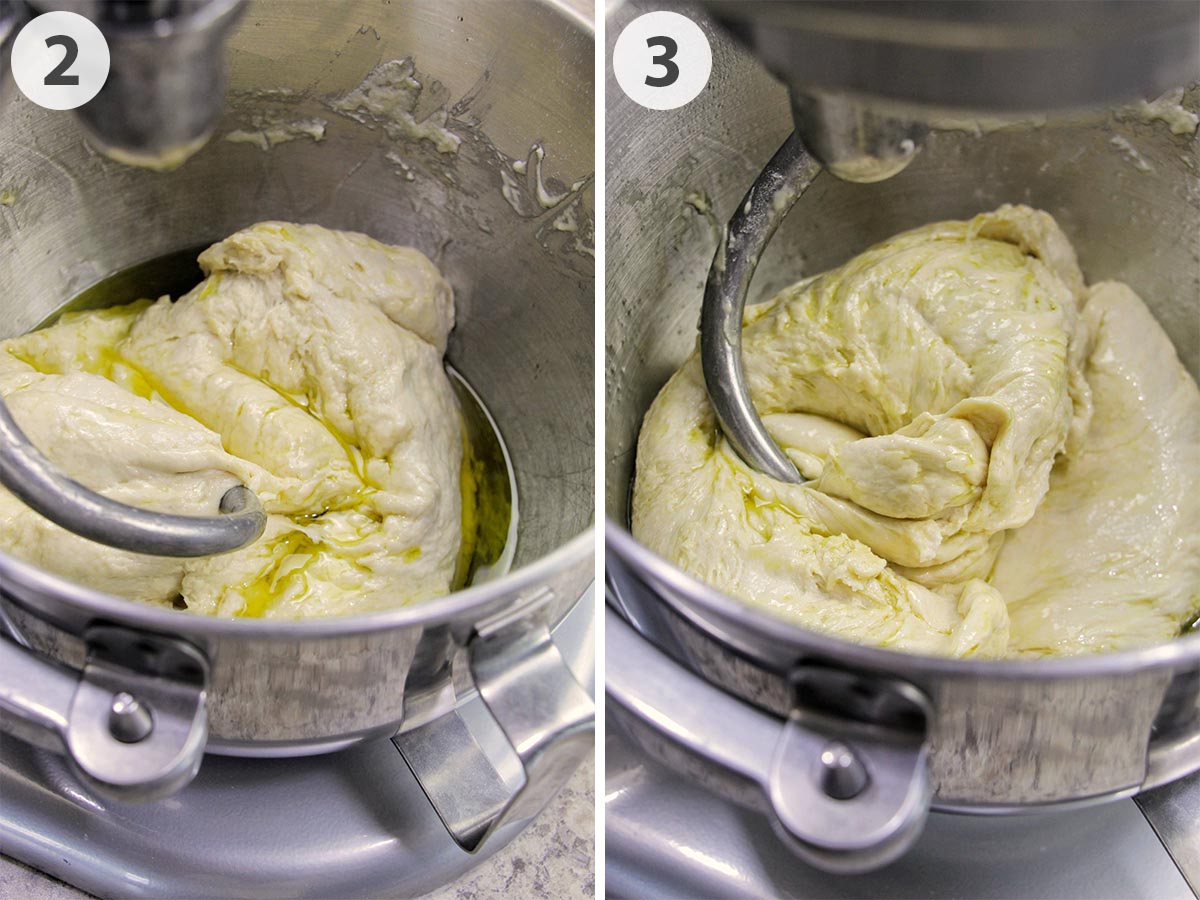
2. After the sugar is mixed in, add the extra virgin olive oil in four batches. Because of the slick consistency of the oil, I find it best to pour it into the center of the dough, which allows it to absorb into the flour easier.
If you see the olive oil sinking to the bottom of the mixing bowl, causing your dough to spin around instead of mixing properly, use a silicone spatula to scoop and flip the dough around the dough hook so it catches and continues to mix.
This step definitely takes patience because you have to add the extra virgin olive oil slowly. Just like with the water, if you added all the oil in at once, the flour would not be able to absorb it all.
After you add the last batch of oil, add in the fine sea salt and continue to mix until the oil has been absorbed.
The salt will help strengthen the gluten net and allow the remaining oil to easily absorb into the dough.
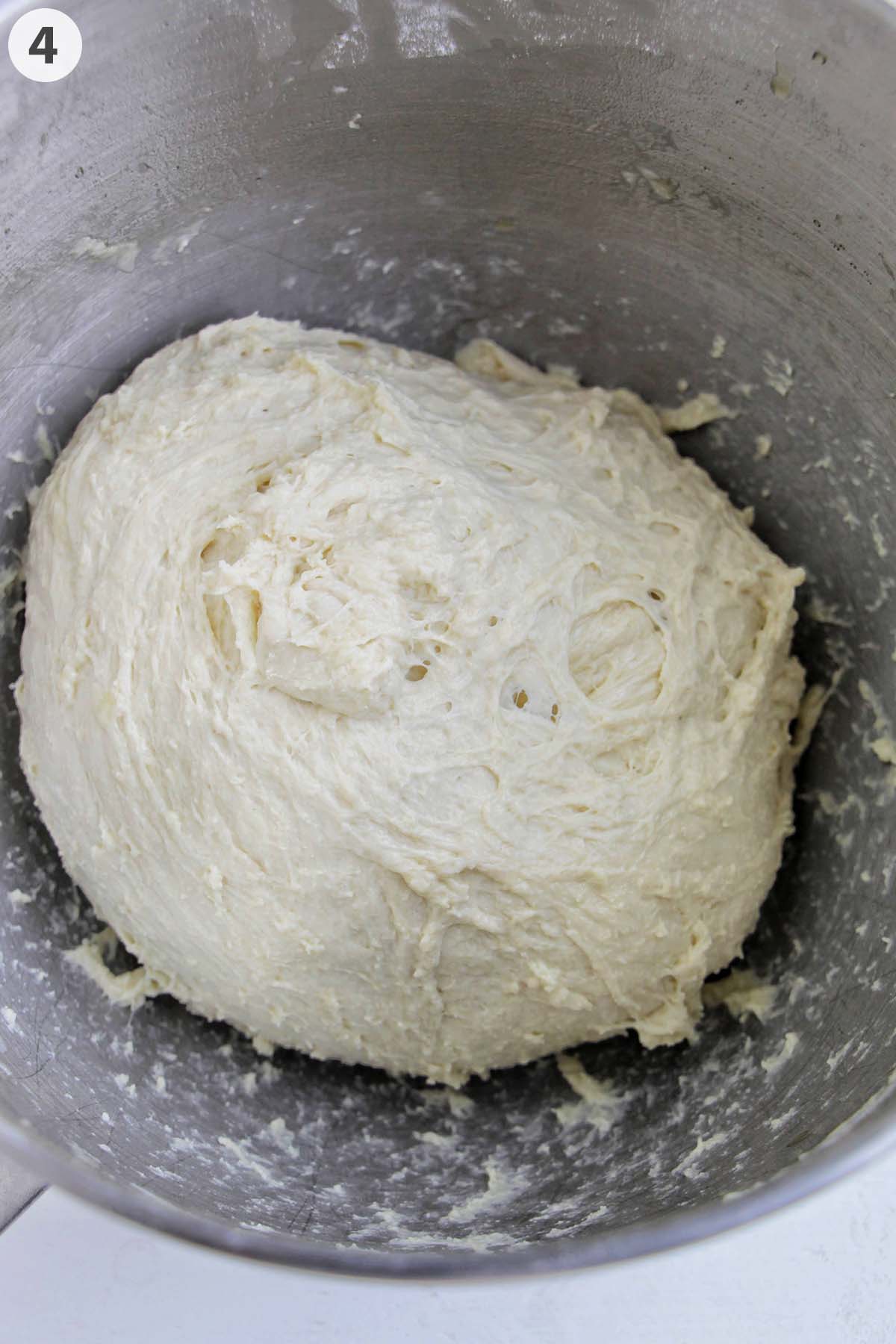
4. Once the dough has fully formed, increase the speed on your mixer to high, and let this mix for 1-2 minutes. The two indicators that your dough is done are a popping sound and seeing the dough wrapped closely around the dough hook.
The focaccia dough will be smooth and quite sticky when it's done mixing.
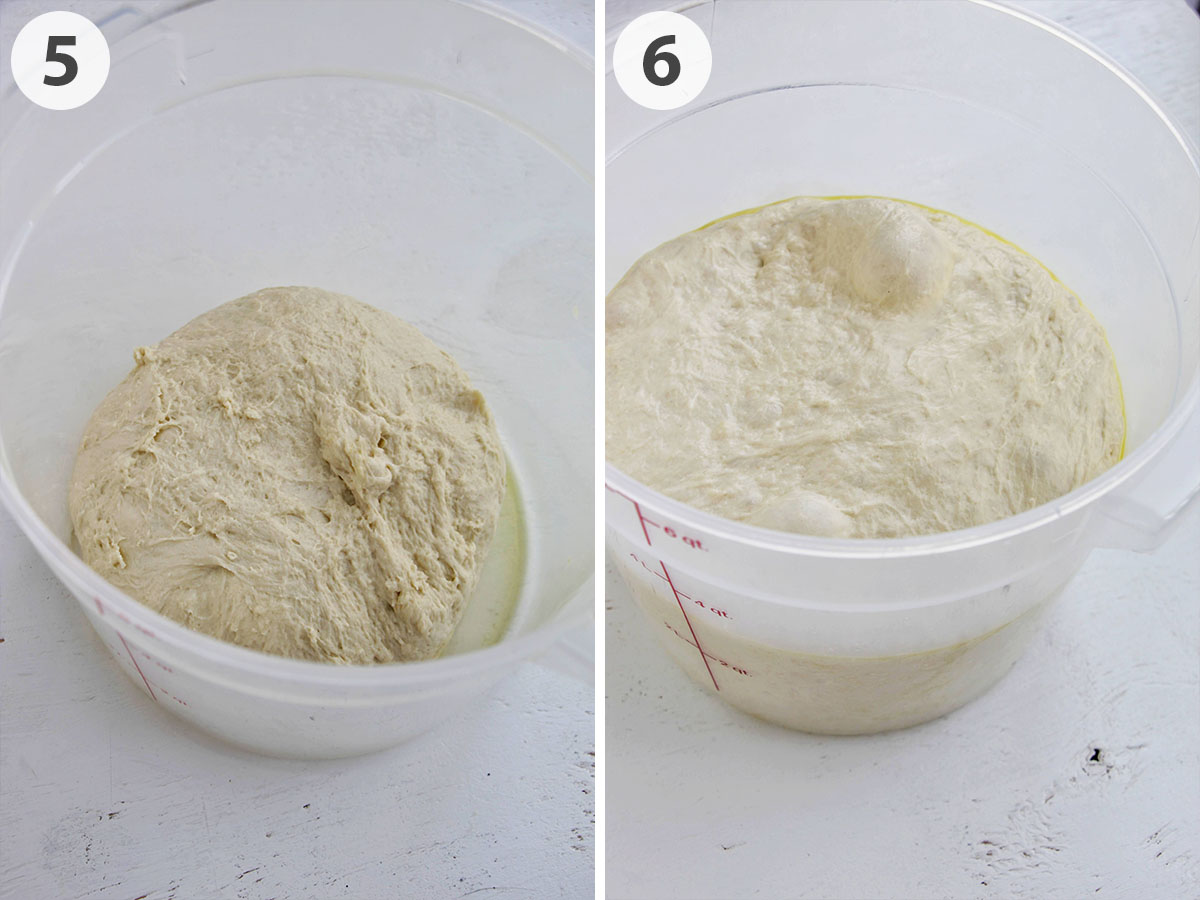
5. Now that the dough is formed, shape it into a tight ball, and place it in a lightly oiled container about 3 times the size of the dough ball. I love using these food storage containers for my dough.
A helpful trick when shaping your dough into a ball is to put a little extra virgin olive oil on your hands to prevent the dough from sticking to them. Additionally, try and work quickly. The longer you leave your hand against the dough, the more it will stick to you.
6. Cover the bowl with plastic wrap and place it to rise in a warm, draft-free area until it has tripled in size. Do not let impatience get the best of you at this stage. This step is essential to getting a nice fluffy cheese focaccia bread.
On average, this step takes between 3 and 5 hours. However, if you live in a cold environment, the rise time may increase.
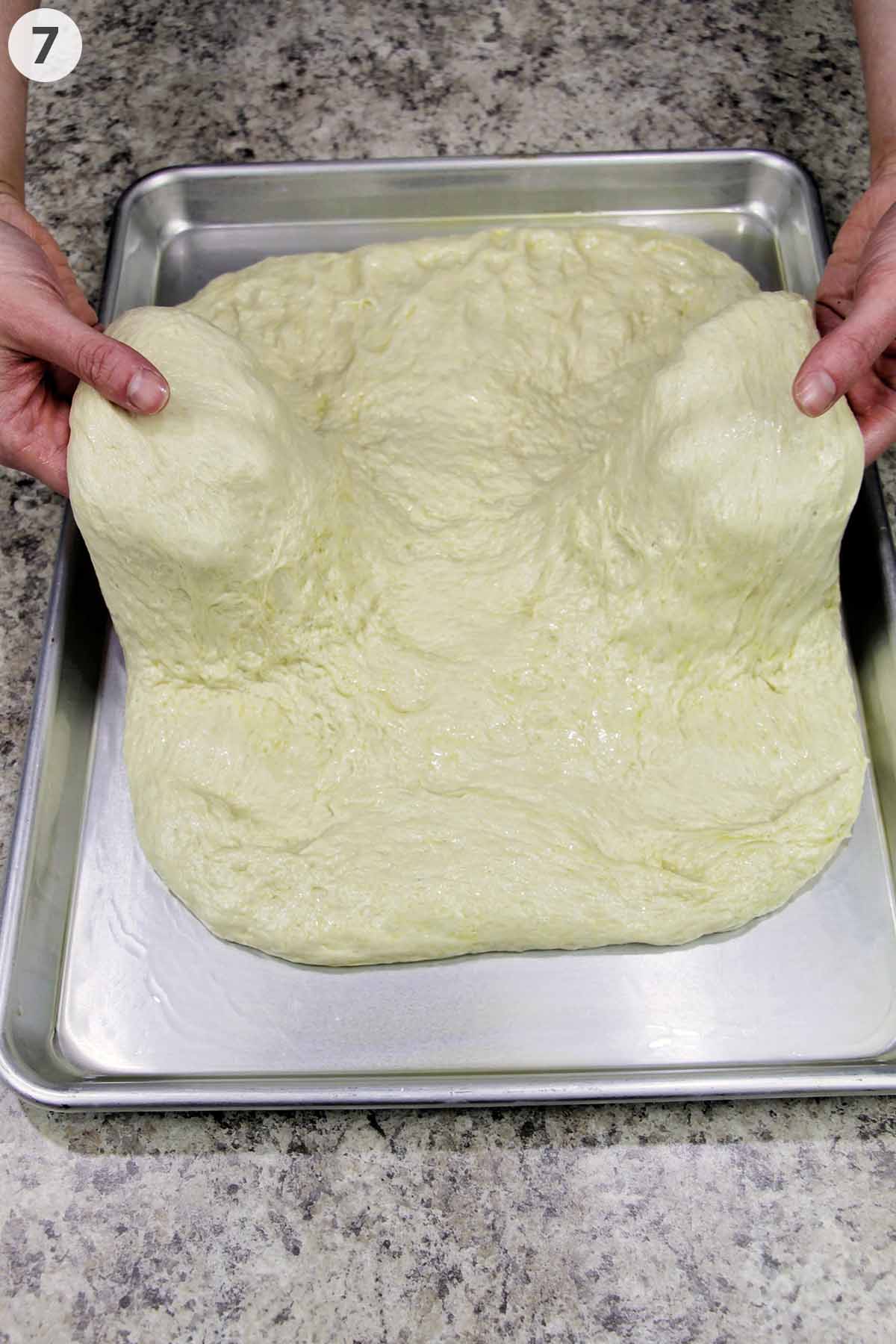
7. Once you have waited patiently for the dough to triple in size, generously oil the bottom and sides of a 12 x 18 inch (30 x 45 cm) sheet pan with extra virgin olive oil.
Place the dough on the sheet pan. To stretch the dough to fit the dimensions of the pan, allow gravity to stretch the dough instead of stretching it forcefully. To do this, gently lift sections of the dough and allow gravity to stretch it.
If you notice that the dough keeps pulling back towards the center of the pan, let the dough rest for an extra 10 minutes or so. Once it has rested, continue to stretch. This extra rest time allows the gluten net to relax and become more pliable.
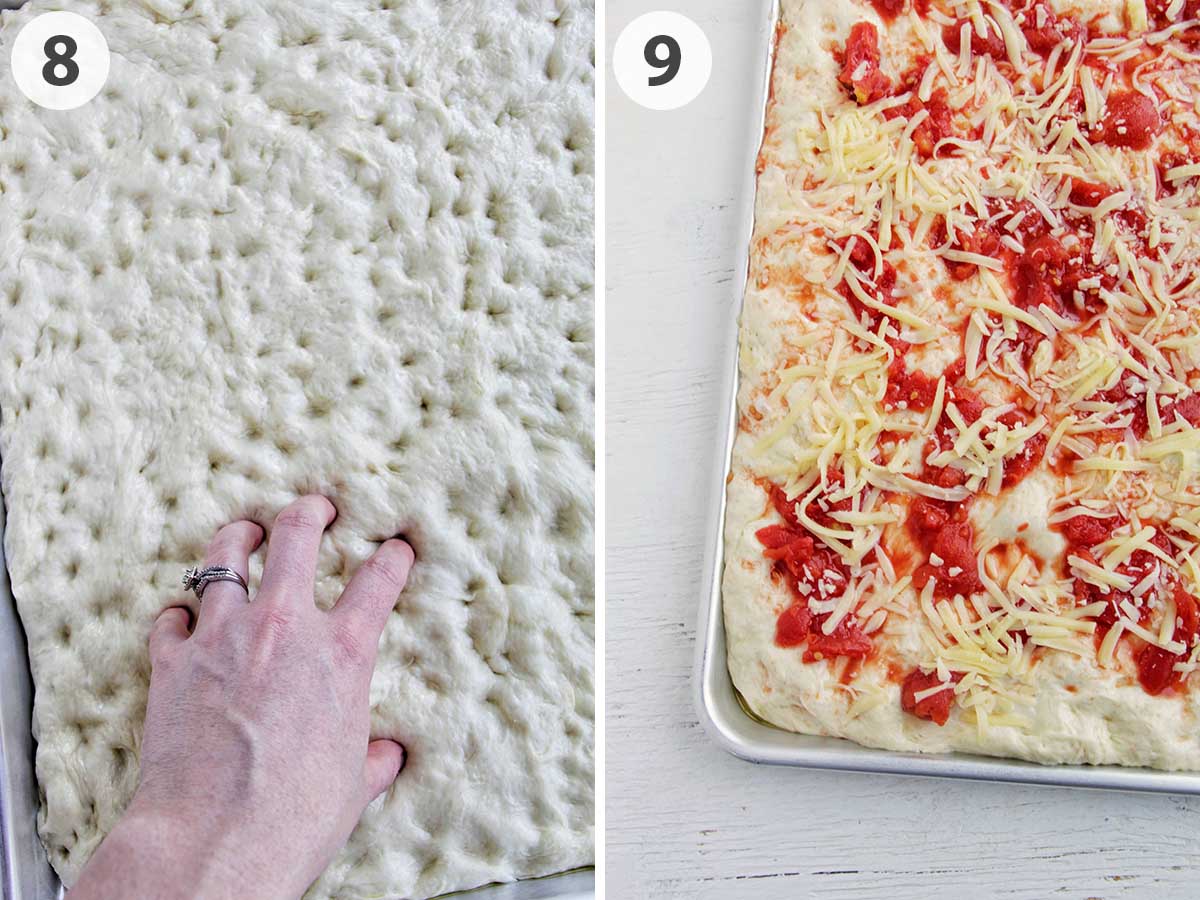
8. After the dough is stretched, use your fingertips to make indentations on top of the focaccia dough. Be sure you do not fully penetrate the dough to the point where you can see the pan underneath. This will damage the dough.
9. Now that you’ve gotten your dough prepared, you can move on to the focaccia topping.
For the topping, crush the tomatoes with your hands over the focaccia dough. Spread the tomato as evenly as you can across the dough. If you have any extra tomato juice, pour it onto the dough as well.
With the tomatoes on, you can now sprinkle the part-skim mozzarella cheese and the sea salt flakes evenly on top of the dough.
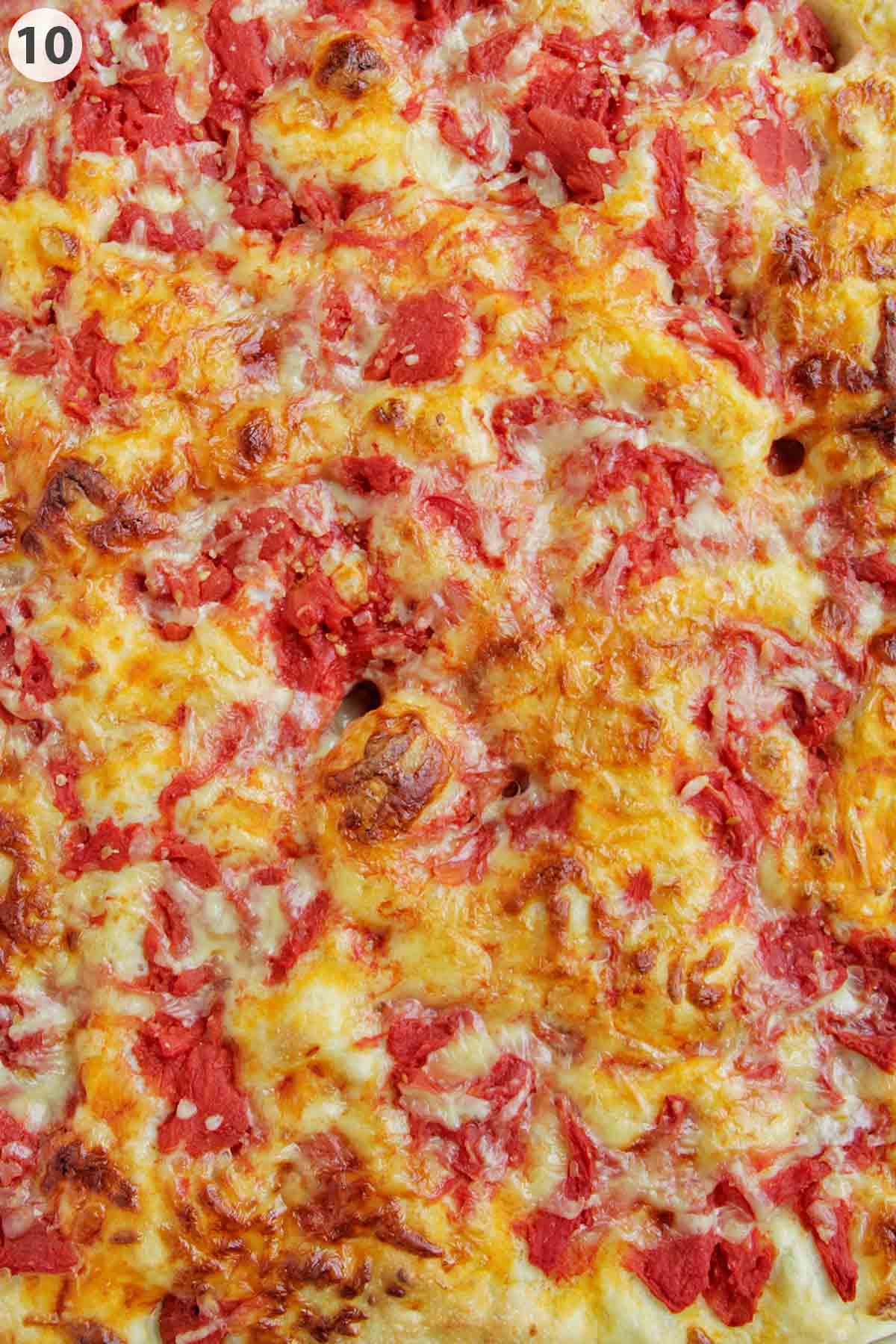
10. Now that your ingredients are all in place, it is time for the home stretch of your focaccia-making process.
Cover the sheet tray with plastic wrap and allow your focaccia to proof in a warm (75°F- 80°F or 24°C - 27°C) draft-free place until it has tripled in size. This usually takes about 60 minutes.
I like to set my oven to a low temperature (170°F - 200°F or 76°C - 93°C), then place the bread to proof on top of the warm oven.
Once the bread has been proofed, it should be extremely airy. Be extra careful when handling the tray at this stage. Any little bump or bang will knock the air out of your focaccia dough.
Next, place your oven rack in an upper middle slot and heat your oven to 430°F (220°C). Gently remove the plastic wrap from the top of the focaccia dough.
Bake your focaccia for 25-30 minutes in the preheated oven until it is golden brown and crispy on top. The tomatoes should be sizzling and the cheese should be nice and melted.
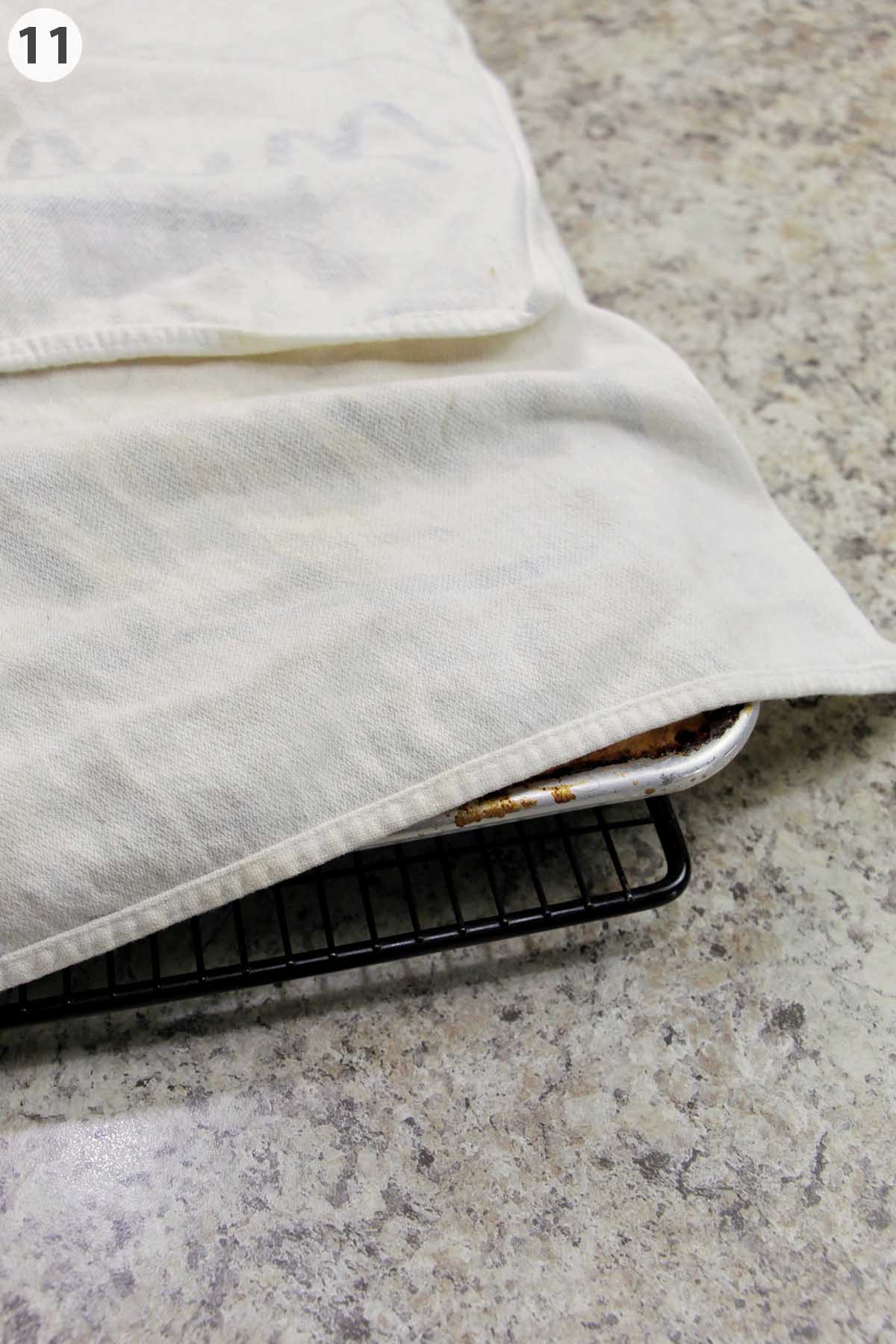
11. When you remove the cheese focaccia bread from the oven, place it on a cooling rack and cover it with a clean tea towel. Covering the focaccia helps the moisture stay inside the bread, making it nice and soft when you eat it.
Allow the focaccia to cool until it reaches room temperature before removing it from the pan. Once removed, you can slice it into 18 individual pieces.
Now that it is portioned, store your bread in an airtight bag in the freezer until it’s ready to be served. Freezing the bread immediately after baking keeps the bread fresh much longer than if you left it out at room temperature.
When you are ready to serve the bread, reheat the focaccia by setting your oven to 350°F (180°C). Line a baking sheet with parchment paper or a silicone pad and place the focaccia portions on top of it. Bake for 18-20 minutes until the focaccia is fully warm and the outside is nice and crunchy.
Expert Tips
- Storing the focaccia at room temperature is not a good idea unless you are planning to eat it the same day. Focaccia is designed to be reheated before serving. Because of this, I highly recommend storing the focaccia in an airtight bag in the freezer until it's time for serving the bread. The bread will stay fresher and better for longer if stored in the freezer.
- Do not be scared to add extra tomato juice on top of the focaccia. The water in the juice helps make the cheese focaccia nice and crispy.
- Looking for a unique way to eat pizza? This cheese focaccia bread with tomatoes is a great option! When you're ready to serve and reheat, add some of your favorite additional pizza topping like olives, bell peppers, or mushrooms.
Recipe FAQs
The final focaccia in this recipe should be about 1 inch or 2.5 centimeters thick.
Focaccia dough takes multiple hours to rise. For my tests, it took between 3 and 5 hours to rise.
The temperature of the environment the dough is resting in will also affect the rise time. Overall, colder temperatures result in longer rise times.
If you have waited 5-8 hours for the dough to rise and it still hasn’t tripled in size, it is likely the yeast you used is dead. This could be a result of either using water that’s too hot or expired yeast. I would suggest buying new yeast and restarting the recipe.
Focaccia is traditionally a light and airy bread. During the baking process, it is important to be careful with the dough. Being too harsh and careless will risk losing the airy qualities that make this dough great.
The most important stage to be cautious in is the proofing stage. During this stage, when the dough is rising a second time before going into the oven, hitting the dough in any way will push out the air in the focaccia. Once the air is knocked out, the dough will become denser.
It is also essential to check that your yeast has not expired. Expired yeast could lead to dense focaccia bread.
My preference for allowing my dough to rise during the bulk fermentation stage is by placing it near a sunny window.
For the proofing stage, I place it on top of my oven set at a low temperature. I recommend turning the oven to 170°F - 200°F or 76°C - 93°C, allowing the warmth from the oven to mimic the heat produced by a proofer in a real bakery.
Do not place the bread inside the oven when doing this. You do not want to start cooking the dough, especially with plastic wrap on top.
I suggest storing your focaccia cheese bread in an airtight bag in the freezer once the dough has cooled to room temperature. Storing freshly baked bread in the freezer helps the focaccia stay fresh for much longer than leaving it sitting at room temperature.
To reheat the frozen dough, preheat your oven to 350°F (180°C). Then, line a baking sheet with parchment paper and place the focaccia slices you want to be heated. Bake for 18-20 minutes until the focaccia is fully warmed through and is nice and crunchy on the outside.
Even if you're not freezing your focaccia, you'll follow these same instructions to reheat the cheese bread before serving.
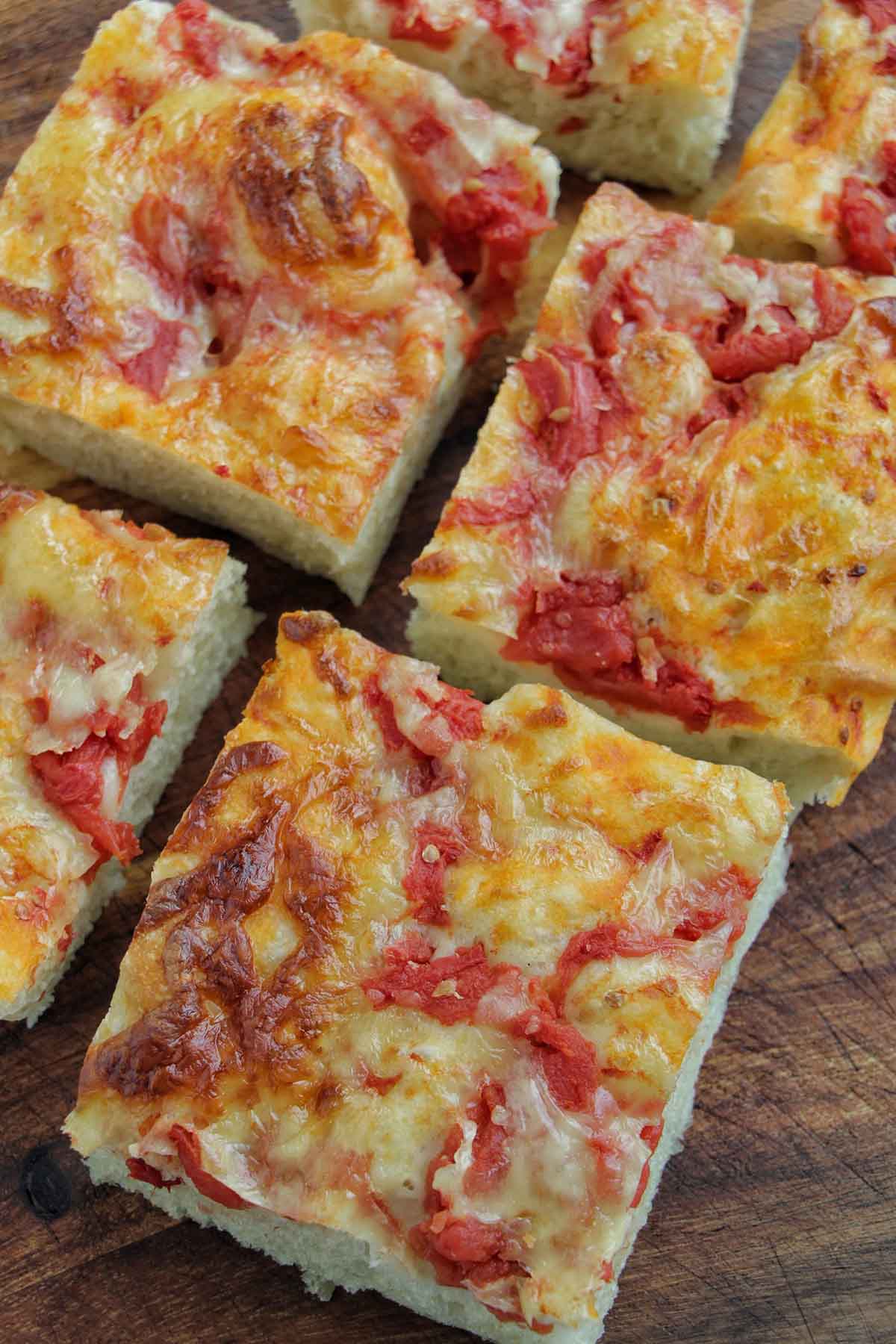
More Focaccia Bread Recipes
If you enjoyed this cheese focaccia bread, check out some of my other favorite bread recipes:
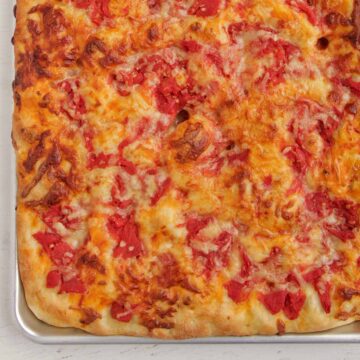
Tomato & Cheese Focaccia Bread
Equipment
- metal half sheet pan (12 x 18 x 1 inch)
- tea towel
Ingredients
- 6 ¼ cups bread flour
- 2 teaspoons instant dry yeast
- 2 cups warm water (105°F - 115°F or 40°C - 46°C)
- 1 tablespoon granulated sugar
- ½ cup plus 2 tablespoons extra virgin olive oil plus more for greasing the sheet pan
- 4 teaspoons fine sea salt
- 2 cups canned whole peeled tomatoes
- 1 cup finely shredded part-skim mozzarella cheese
- 2 teaspoons Maldon sea salt flakes
Instructions
- Mix bread flour and instant dry yeast in a stand mixer fitted with a dough hook attachment on medium low speed. With the mixer running, slowly add water in three batches. Allow the flour to completely absorb the water before adding the next batch.
- Combine sugar; mix thoroughly.
- Slowly pour extra virgin olive oil in the center of the dough in four batches. Mix on medium low speed and allow the flour to slightly absorb the oil before adding the next batch. The extra virgin olive oil takes a while to incorporate. Use a silicone spatula to flip the dough over periodically to help the dough hook catch and knead in the oil. Once you’ve added in your last batch of olive oil, add fine sea salt and mix thoroughly until all the oil has absorbed.
- Bump the mixer speed up to high and mix until you heard a popping sound and the dough wraps around the dough hook, about 1 - 2 minutes. The dough will be smooth but very sticky.
- Roll the dough into a tight ball, then place in an oiled bowl roughly three times the size of the dough. Cover with plastic wrap and allow to rise in a warm, draft-free place until tripled in size. Rise time will vary depending on the temperature of your environment.
- Generously oil the bottom and sides of a 12 x 18 inch (30 x 45 cm) sheet pan with extra virgin olive oil. Use gravity to allow the dough to naturally stretch until it reaches the edge of the sheet pan. If you notice the dough pulling back to center, allow it to rest in the sheet pan for an additional 10 minutes, then continue stretching.
- Use your fingertips to make indentations on top of the focaccia dough. Crush whole peeled tomatoes in your hands over the focaccia dough. Allow the juice and tomatoes to spread across the dough. If there is any leftover tomato juice, pour it over the focaccia dough. Sprinkle mozzarella cheese and Maldon sea salt flakes on top of the tomatoes.
- Cover sheet pan with plastic wrap and allow to proof in a warm (around 75°F - 80°F or 24°C - 27°C), draft-free place until tripled in size, about 60 minutes.
- Place oven rack in an upper middle slot. Heat oven to 430°F (220°C).
- Carefully remove plastic wrap from sheet pan without knocking any air out of the bread dough. Bake for 25 - 30 minutes until golden brown and crispy on the top. Place focaccia on a cooling rack and cover with a tea towel. Allow focaccia to cool to room temperature before removing from the pan and slicing into individual pieces.
- To serve, heat oven to 350°F (180°C). Line a baking sheet with parchment paper and place focaccia slices on top. Bake for 18 -20 minutes until warmed through and crunchy on the outside.

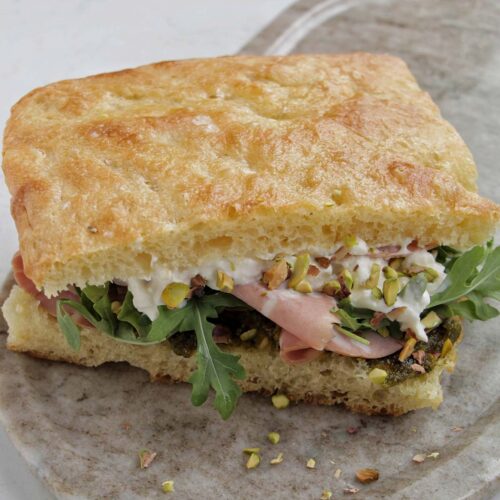

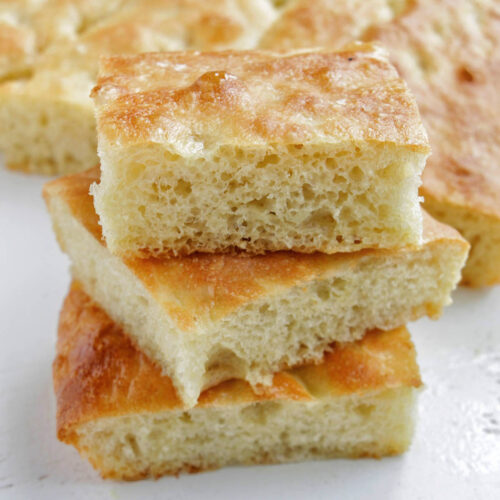
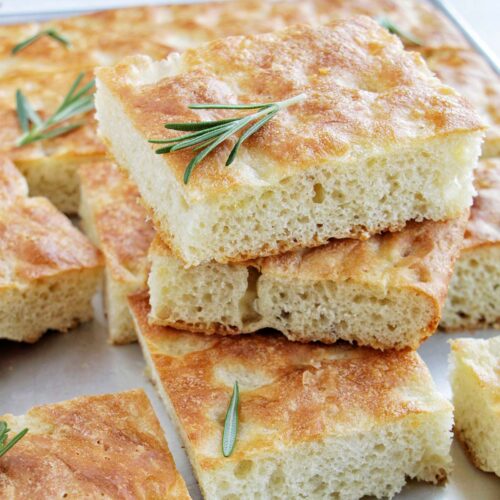

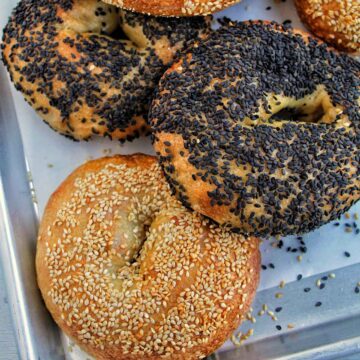

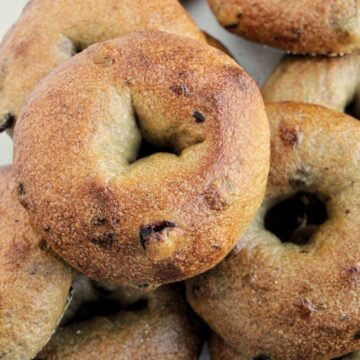
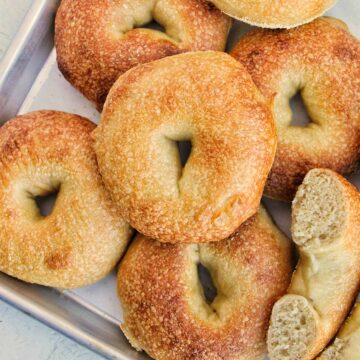
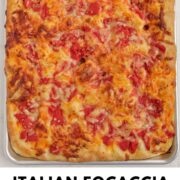
Leave a Reply